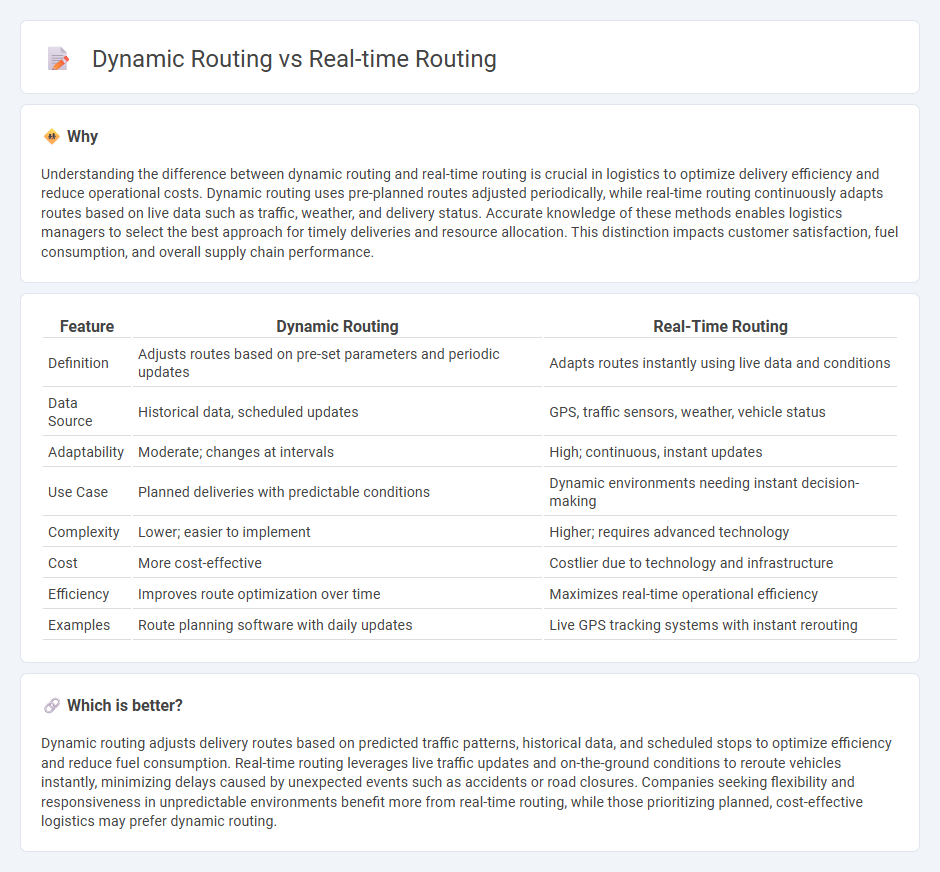
Dynamic routing adjusts delivery paths based on predicted traffic patterns and historical data, optimizing efficiency over planned schedules. Real-time routing continuously updates routes by processing live traffic information, road conditions, and unexpected delays to enhance responsiveness and accuracy. Explore the differences and benefits of these routing strategies to streamline your logistics operations.
Why it is important
Understanding the difference between dynamic routing and real-time routing is crucial in logistics to optimize delivery efficiency and reduce operational costs. Dynamic routing uses pre-planned routes adjusted periodically, while real-time routing continuously adapts routes based on live data such as traffic, weather, and delivery status. Accurate knowledge of these methods enables logistics managers to select the best approach for timely deliveries and resource allocation. This distinction impacts customer satisfaction, fuel consumption, and overall supply chain performance.
Comparison Table
| Feature | Dynamic Routing | Real-Time Routing |
|---|---|---|
| Definition | Adjusts routes based on pre-set parameters and periodic updates | Adapts routes instantly using live data and conditions |
| Data Source | Historical data, scheduled updates | GPS, traffic sensors, weather, vehicle status |
| Adaptability | Moderate; changes at intervals | High; continuous, instant updates |
| Use Case | Planned deliveries with predictable conditions | Dynamic environments needing instant decision-making |
| Complexity | Lower; easier to implement | Higher; requires advanced technology |
| Cost | More cost-effective | Costlier due to technology and infrastructure |
| Efficiency | Improves route optimization over time | Maximizes real-time operational efficiency |
| Examples | Route planning software with daily updates | Live GPS tracking systems with instant rerouting |
Which is better?
Dynamic routing adjusts delivery routes based on predicted traffic patterns, historical data, and scheduled stops to optimize efficiency and reduce fuel consumption. Real-time routing leverages live traffic updates and on-the-ground conditions to reroute vehicles instantly, minimizing delays caused by unexpected events such as accidents or road closures. Companies seeking flexibility and responsiveness in unpredictable environments benefit more from real-time routing, while those prioritizing planned, cost-effective logistics may prefer dynamic routing.
Connection
Dynamic routing and real-time routing are interconnected through their shared goal of optimizing delivery efficiency by continuously updating routes based on current traffic, weather, and demand conditions. Both systems leverage advanced algorithms and GPS data to minimize transit times, reduce fuel consumption, and improve overall supply chain responsiveness. Real-time routing enhances dynamic routing by providing instant feedback and adjustments, enabling logistics companies to adapt swiftly to unforeseen disruptions.
Key Terms
GPS Tracking
Real-time routing leverages GPS tracking to provide instant, constantly updated navigation paths that adapt to current traffic conditions, road closures, and other immediate factors. Dynamic routing, while also responsive to changes, emphasizes automated, algorithm-driven adjustments based on predictive analytics and historical data to optimize long-term route efficiency. Explore how integrating GPS tracking enhances both routing methodologies for smarter, more efficient navigation solutions.
Algorithm Optimization
Real-time routing algorithms prioritize immediate data processing to optimize path selection based on current network conditions, minimizing latency and maximizing efficiency. Dynamic routing relies on adaptive algorithms that update routes periodically in response to network changes, focusing on long-term optimization and stability. Explore further to understand how algorithm optimization drives performance in real-time versus dynamic routing systems.
Traffic Data Integration
Real-time routing utilizes up-to-the-minute traffic data, GPS updates, and sensor inputs to continuously adjust routes, minimizing delays and congestion. Dynamic routing adapts to changing network conditions but may rely on periodic updates rather than instantaneous traffic information. Explore the advantages of real-time traffic data integration for optimized navigation and efficient route management.
Source and External Links
How real-time route optimization software works - Intellias - Real-time routing uses big data like vehicle telemetry, traffic, and mapping info processed by machine learning algorithms to automatically generate and update the best travel routes dynamically.
Real-Time Route Monitoring: The Role of Live Tracking APIs in ... - Live tracking APIs enable real-time vehicle monitoring to dynamically adapt routes based on traffic, improve ETA accuracy, reduce fuel costs, and enhance fleet management and safety.
Real-Time Routing vs CCIO Batch Processing - LeanData Help Center - Real-time routing processes records instantaneously in Salesforce triggers, increasing speed and accuracy compared to batch processing for better lead routing efficiency.
 dowidth.com
dowidth.com